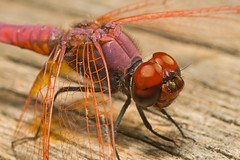I really like the way that natural light macro looks, with the subject and the background equally well lit. But there is never enough low contrast natural light for the kind of hand held images I like to take, and using a tripod is out of the question. By the time I got setup the critter would be long gone, and even if it didn’t take off the slightest little movement would ruin the shot anyway…
So what I need is the background illumination that’s possible with natural light, but the motion stopping power of a low duration burst of flash light. With the MT-24EX and a flash bracket it’s possible to get both.
I have a Really Right Stuff flash bracket and some extenders for it. So I set one flash low to the lens and pointed it directly at the dragonfly in the photo included with this post. I set the other flash head on an extender and positioned it above the critter and pointing down to use it as fill flash for the area I’m shooting. I got a little bit of reflection from the direct flash –and I think I can work that out in time. But look at the overall illumination in the frame. Not too bad…
You don’t have to use a Really Right Stuff bracket and extender –you could put one flash head on the standard Canon flash mount for the MT-24EX and then place the other flash head on a bracket. The advantage to using the RRS bracket and extender is that I can position both flash heads toward the top of the lens where it’s easier for me to keep from bumping into things with them. I also have more angles available to me with the RRS mount than I can get out of the standard flash mount that comes with the MT-24EX.
Using one flash head for fill also works well when you’re shooting an insect from the side and you want to illuminate the area directly behind it. Just angle the “fill flash” so that it is pointing toward the area you want to light up.
So far I’ve tested using one flash head for fill all the way to 4x and the flash cycle time is fast –meaning that the flash duration is short and I’m able to freeze motion. Not only am I stopping the motion of the subject, but I’m stopping my own motion as well with just one flash head without having to go above ISO 100. Sweet…


3 comments:
Have you ever experimented with using your 430EX as a slave and firing it in addition to both heads on the MT-24EX? You could mount the 430EX on an extender and illuminate the background while hitting the subject with the MT-24EX. Just a thought...
I find that in macrophotography light is your friend and the more extreme you get, the more friendly it becomes. While having a slave(s) off of the mt-24ex can work wonderful, it can also get very cumbersome. It is a trade off.
I found that 2 external flashes on a lepp style bracket actually works better than the twinflash, but it is also a lot more cumbersome.
@ shagdiver: I have used a 430EX as a slave off of my MT-24EX, but only under controlled conditions. It's too cumbersome to use when I'm out chasing critters around ;)
@ mark: It's tough to beat the Twin flash for what it can do when you factor in size and weight...
Post a Comment